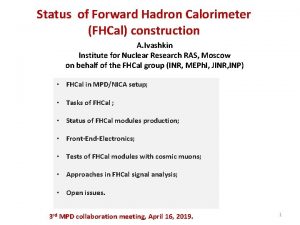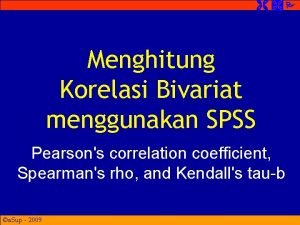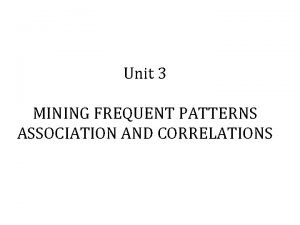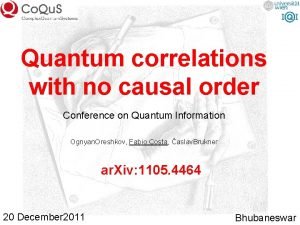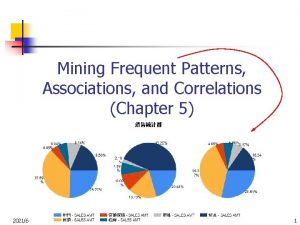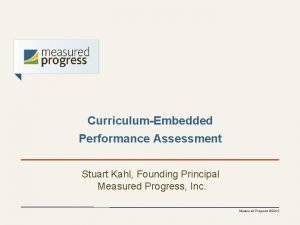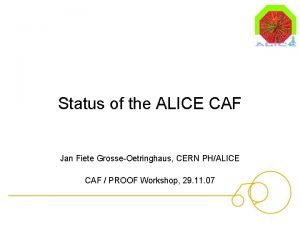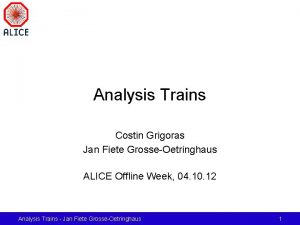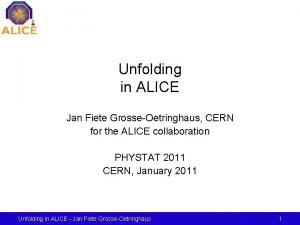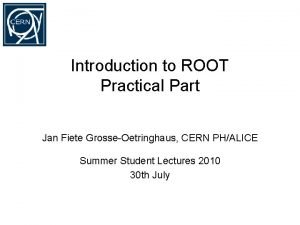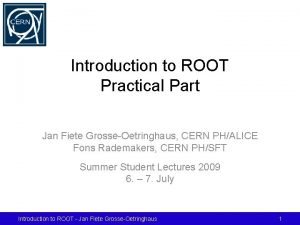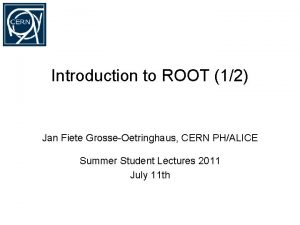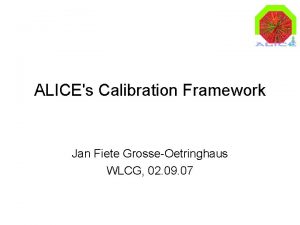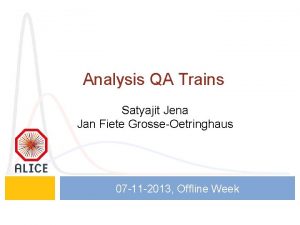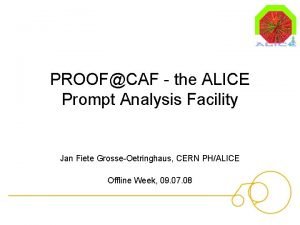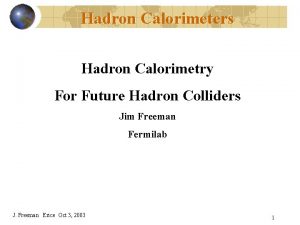Hadron Correlations Measured with ALICE Jan Fiete GrosseOetringhaus


















- Slides: 18

Hadron Correlations Measured with ALICE Jan Fiete Grosse-Oetringhaus, CERN for the ALICE Collaboration Hard Probes, Cagliari, 29. 05. 12 Hadron Correlations Measured with ALICE - Jan Fiete Grosse-Oetringhaus 1

In-Medium Modification at LHC • Strong quenching in central HI collisions at LHC – RAA ~ 0. 14 [ALICE, ATLAS, CMS] – IAA ~ 0. 5 (away side) IAA ~ 1. 2 (near side) [ALICE] – Strong di-jet energy asymmetry, but jet fragmentation (of the quenched parton) only minimally modified [ATLAS, CMS] – Quenched energy reappears at low p. T, IAA also outside the jet cone [CMS] • Study the low p. T region where the energy reappears 0 -5% 60 -90% – Interactions of remnants of a high energetic parton interact with the collectivity-dominated bulk? • Two-particle correlations allow to extract a small signal over a background dominated by combinatorics and collectivity – Near-side peak shapes, p/p ratio in jet and bulk, high p. T flow PRL 108, 092301 p. T, assoc (Ge. V/c) See talks by • Andreas Morsch (Mon 15: 40) • Misha Veldhoen (Mon 16: 30) Hadron Correlations Measured with ALICE - Jan Fiete Grosse-Oetringhaus 2

Near-Side Peak Shapes • Can we see modification of the near-side peak at low p. T? • On the near-side the jet peak is concentrated around Dh = 0 • Estimate Dh-independent effects (e. g. flow) by studying the long-range correlation region (|Dh| > 1) • Remove from short-range region (|Dh| < 1) |Dh| < 1 1 < |Dh| < 1. 6 Signal Dh Dj Hadron Correlations Measured with ALICE - Jan Fiete Grosse-Oetringhaus Dj 3

Analysis Details Same event • Event sample – 15 M Pb-Pb events at s. NN = 2. 76 Te. V – 55 M pp events at s = 2. 76 Te. V • Track selection benefits from uniform j acceptance of TPC – |h| < 0. 9 – Two-track efficiency cut on distance of closest approach of a track pair in the TPC volume Mixed event • Event mixing corrects for two-track acceptance [in bins of centrality and vertex position] • Per-trigger yields corrected for tracking efficiency and contamination (no influence on shapes) Hadron Correlations Measured with ALICE - Jan Fiete Grosse-Oetringhaus 4

Shape Evolution 2 < p. T, trig < 3 1 < p. T, assoc < 2 0 -10% Dh 60 -70% Dj Dh Dj pp Dh Dj p. T 4 < p. T, trig < 8 2 < p. T, assoc < 3 • Wider peak in central collisions • Peripheral and pp similar • Strong p. T dependence Aim: Characterize the peak Dh Dh Dj Dj Hadron Correlations Measured with ALICE - Jan Fiete Grosse-Oetringhaus Dh Dj 5

Peak Characterization • Quantification with rms (~ s) and excess kurtosis K – K = m 4 / m 22 – 3 (mn nth moment) = measure of the peakedness Laplace: K=3, Gaussian: 0, semi-circle: -1, uniform -1. 2 • rms determined with two independent methods: fitting and projections – Fit with a suitable function (sum of 2 2 D Gaussians (h, j)) • 4 shape parameters: s. Dh, s. Dj, KDh, KDj Data Dh Dj Dh Fit details in talk by Andreas Residual. Morsch More Dh (Mon 15: 40) Dj Dj Hadron Correlations Measured with ALICE - Jan Fiete Grosse-Oetringhaus 6

2 < p. T, t < 3 3 < p. T, t < 4 2 <3 3< <p p. T, t < 4 3 <4 4< <p p. T, t < 8 4 <8 4< <p p. T, t < 8 1 < p. T, a < 2 Ge. V/c 1 < 2 Ge. V/c 2< <p p. T, a < 3 Ge. V/c 2 < 3 Ge. V/c 1< <p p. T, a < 2 Ge. V/c 2 < 3 Ge. V/c 2< <p p. T, a < 3 Ge. V/c Centrality | 100 = pp s. Dh (fit) s. Dj (fit) (rad. ) Near-Side Peak: s (fit) Centrality | 100 = pp • No significant centrality dependence of s. Dj – Dependence on p. T, assoc governed by j. T ~ p. T, assoc · s. Dj • Significant increase of s. Dh towards central events • Smooth continuation from peripheral to pp Hadron Correlations Measured with ALICE - Jan Fiete Grosse-Oetringhaus 7

• Significant increase of s. Dh towards central events s. Dj , s. Dh (fit) Peak Deformation 2 < p. T, t < 3 4 < p. T, t < 8 1 < p. T, a < 2 Ge. V/c 2 < p. T, a < 3 Ge. V/c s. Dh s. Dj – s. Dh > s. Dj (eccentricity ~ 0. 2) • Armesto, Salgado, Wiedemann suggested that longitudinal flow can deform the conical jet shape (PRL 93, 242301 (2004)) Centrality | 100 = pp Calculation + STAR prel: h rms (calc. ) j rms (calc. ) • Interplay of flow with the jet? PRL 93, 242301 (2004) Hadron Correlations Measured with ALICE - Jan Fiete Grosse-Oetringhaus d. Nch/dh 8

AMPT Comparison • AMPT (A Multi. Phase Transport Code) describes collective effects (e. g. v 2, v 3, v 4) in HI collisions at LHC – Here version with string melting (2. 25) is shown • It also does rather well for the rms of the near-side peak 2 < p. T, t < 3 3 < p. T, t < 4 4 < p. T, t < 8 1 < p. T, a < 2 Ge. V/c 2 < p. T, a < 3 Ge. V/c Lines: AMPT 2. 25 and Pythia P-0 (for pp) Centrality | 100 = pp s. Dh (fit) (rad. ) s. Dj (fit) (rad. ) – Interplay of jet and flow in AMPT via parton and hadron scattering Centrality | 100 = pp Hadron Correlations Measured with ALICE - Jan Fiete Grosse-Oetringhaus 9

– Near-side is less peaked towards central collisions – Described rather well with AMPT Kurtosis Dj • Excess kurtosis shows clear evolution with centrality for j and h Kurtosis Dh Kurtosis 2 < p. T, t < 3 3 < p. T, t < 4 4 < p. T, t < 8 1 < p. T, a < 2 Ge. V/c 2 < p. T, a < 3 Ge. V/c Lines: AMPT 2. 25 and Pythia P-0 (for pp) Centrality | 100 = pp Hadron Correlations Measured with ALICE - Jan Fiete Grosse-Oetringhaus 10

Departure from Gaussian • The lowest p. T bin shows a structure with a flat top in Dh • This feature is reproduced by AMPT Data AMPT 0 -10% 2 < p. T, t < 3 Ge. V/c 1 < p. T, a < 2 Ge. V/c Dj , Dh • Qualitative and quantitative agreement of peak shapes with AMPT compatible with hypothesis of interplay of jets with the flowing bulk See talk by Andreas Morsch (Mon 15: 40) Hadron Correlations Measured with ALICE - Jan Fiete Grosse-Oetringhaus 11

p/p Ratio in Jet and Bulk • Baryon over meson ratios differ significantly between AA and pp collisions Pb-Pb 0 -5% pp – Attributed to radial flow and coalescence/recombination • How do these ratios behave in a jet in AA collisions? • Two-particle correlations allow to disentangle the bulk from particles associated with a trigger particle • We measure the p/p ratio in the peak and the bulk Bulk I Dh Peak region Bulk II Dj (rad. ) Hadron Correlations Measured with ALICE - Jan Fiete Grosse-Oetringhaus 12

Analysis Details • 0 -10% centrality; trigger particles: 5 < p. T, trig < 10 Ge. V/c • Associated particles: 1. 5 < p. T, assoc < 4. 5 Ge. V/c t. TOF - <t. TOF>p (ps) – Combined particle identification with specific energy loss in the TPC and time of flight in the TOF p K Data Fit p d. E/dx - <d. E/dx>p (a. u. ) t. TOF - <t. TOF>p (ps) Hadron Correlations Measured with ALICE - Jan Fiete Grosse-Oetringhaus d. E/dx - <d. E/dx>p (a. u. ) 13

Particle Yields 1/Ntrig d. N/dp. T, assoc (c/Ge. V) • Particle yields are measured in peak and bulk region and corrected for tracking and PID efficiency • Difference of peak and bulk is the yield associated to the trigger particle p+ + p. Peak Bulk p + pbar Peak Bulk p. T, assoc (Ge. V/c) Hadron Correlations Measured with ALICE - Jan Fiete Grosse-Oetringhaus p. T, assoc (Ge. V/c) 14

p/p Ratio (p+pbar)/(p++p-) ratio • p/p ratio in the bulk is consistent with inclusive p/p ratio – NB. Inclusive ratio in 0 -5% and feeddown corrected • p/p ratio in peak - bulk is significantly smaller Bulk Peak-Bulk Pythia – Consistent with ratio from Pythia (6. 4 default tune) Bulk Inclusive • No evidence for mediuminduced modification of jet fragmentation (R ~ 0. 40. 5) in this p. T regime not feeddown corrected p. T, assoc (Ge. V/c) See talk by Misha Veldhoen (Mon 16: 30) Hadron Correlations Measured with ALICE - Jan Fiete Grosse-Oetringhaus 15

Flow at High p. T • v 2, v 3, v 4 was measured to 20 Ge. V/c in 6 centrality classes (0 -5% to 40 -50%) • v 2 flattens at high p. T, stays positive and increases towards mid-centrality – Path-length dependent quenching – Described by WHDG calculation 0 -5% v 2{EP} (filled) v 2{4} (open) v 3{EP} v 4/ 4{EP} v 4/ 2{EP} 20 -30% • v 3 shows weak centrality dependence • v 4 consistent with 0 within (large) uncertainties for p. T > 8 Ge. V/c ar. Xiv: 1205. 5761 Hadron Correlations Measured with ALICE - Jan Fiete Grosse-Oetringhaus p. T (Ge. V/c) 16

Flow Fluctuations • v 2{2} and v 2{4} allow an estimate of flow fluctuations non-flow d small 0 -5% (open) 5 -10% (filled) 10 -20% 30 -40% 20 -30% 40 -50% • Relative flow fluctuations only weakly dependent on p. T common origin of flow fluctuations ar. Xiv: 1205. 5761 p. T (Ge. V/c) Hadron Correlations Measured with ALICE - Jan Fiete Grosse-Oetringhaus 17

Conclusions • Asymmetric near-side peak in central Pb-Pb collisions – The Dh rms shows a strong centrality dependence, contrary to Dj – rms and excess kurtosis are well reproduced by AMPT – Interplay of the jet with flow? • Associated p/p ratio to a trigger particle much smaller than in the bulk and compatible with vacuum fragmentation – No evidence for medium-induced modification of jet fragmentation • Relative v 2 fluctuations only weakly dependent on p. T – Common origin of flow fluctuations • These observations are intriguing and a combination of these studies seems promising – PID-dependent shape, p/p ratio at different distances from trigger particle in particular in the tails of the distribution Hadron Correlations Measured with ALICE - Jan Fiete Grosse-Oetringhaus 18
 Hadron
Hadron Hadron calorimeter
Hadron calorimeter Hadron
Hadron Hadron collider
Hadron collider Hadron collider
Hadron collider Analisis korelasi bivariat
Analisis korelasi bivariat Thinking critically
Thinking critically Eclat algorithm
Eclat algorithm Mining frequent patterns associations and correlations
Mining frequent patterns associations and correlations Quantum correlations with no causal order
Quantum correlations with no causal order Mining frequent patterns associations and correlations
Mining frequent patterns associations and correlations Spurious correlations
Spurious correlations Shapes that are smooth even edges and are measurable
Shapes that are smooth even edges and are measurable Measured progress
Measured progress Items measured in kilograms
Items measured in kilograms How to find pressure potential
How to find pressure potential Spt hammer types
Spt hammer types How volume is measured
How volume is measured I have measured out my life
I have measured out my life

